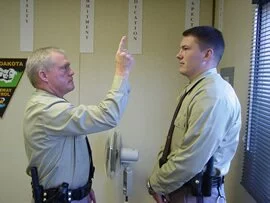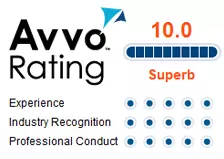Many of Michigan’s police officers are trained to administer a test called the “Horizontal Gaze Nystagmus” (HGN) test while investigating Michigan’s drivers for alleged drunk driving. The HGN is one of the National Highway Traffic Safety Administration’s (NHTSA) three Standardized Field Sobriety Tests. (SFSTs). Trouble is, in more than ninety percent of cases the officer administers it wrong.
But what does this mean? According to the Michigan DUI case of People v. Berger, [W]e conclude the only foundation necessary for the introduction of evidence regarding the HGN test in Michigan is evidence that the test was properly performed and that the officer administering the test was qualified to perform it. The trouble with the Berger case is that it does not define what “properly performed” actually means.
According to the seminal case of Illinois vs. McKown:
The methodology employed by law enforcement officers for conducting an HGN testing as a part of field-sobriety testing is explained in detail in our earlier opinion. In brief, the officer first questions the subject to determine whether he or she has any medical condition or is taking any medication that might affect the results of the test. If not, the officer performs a preliminary test to determine whether the pupils of the subject’s eyes are of equal size and whether the eyes “track” equally as an object is moved, at eye level, from side to side. If so, the HGN test itself is performed. The officer looks for three “clues,” assessing each eye separately. The three clues are lack of smooth pursuit, distinct nystagmus at maximum deviation, and the onset of nystagmus at an angle less than 45 degrees. One point is assigned for each clue that is present in either eye. Thus, the maximum score is six, which would indicate all three clues present in both eyes. A score of four or more is considered “failing” and indicative of alcohol impairment.
Of course this is not a Michigan case, and Illinois case law doesn’t really mean all that much in Michigan. And there is no case in Michigan definitively that says what “properly performed” actually means.
There is one case though that does suggest that the NHTSA standard does apply. This is the case of People v. Mullen, which did not address this issue directly. Nevertheless, the court did find, according to the NHTSA training manual:
Although Officer Shuler testified that he knew and understood these factors, he generically stated in the affidavit that “nystagmus is present” without revealing that he had the stimulus too close to defendant’s eyes. Because nystagmus occurs naturally and is always present, the fact that the test had not been performed accurately was a significant omission in the warrant affidavit reviewed by the magistrate. We agree with the circuit court that Officer Shuler’s incorrect administration of the HGN test led to an inaccurate interpretation of the results, and that Officer Shuler acted with at least reckless disregard for the truth when including the misleading statement about the HGN test results in the affidavit.
In this opinion the court recognized the NHTSA manual as the “rule book” that Michigan police must follow, and based on this case it can be concluded, that at least in dicta, that Michigan has adopted the NHTSA training manual as being the “authority” when it comes to determining if the HGN was “properly performed.”
In a Michigan Bar Journal article addressing HGN and NHTSA, the authors suggest that:
“[F]inally, if there is a videotape of the stop, a challenge to the HGN is easier because counsel can then observe how the officer performed it, and determine if it was administered correctly. Analyzing videotapes and/or testimony with this level of scrutiny will allow counsel to conclude the test was not administered according to the NHTSA protocol. This may lay a foundation for an evidentiary challenge and perhaps even lead to suppression at trial.










